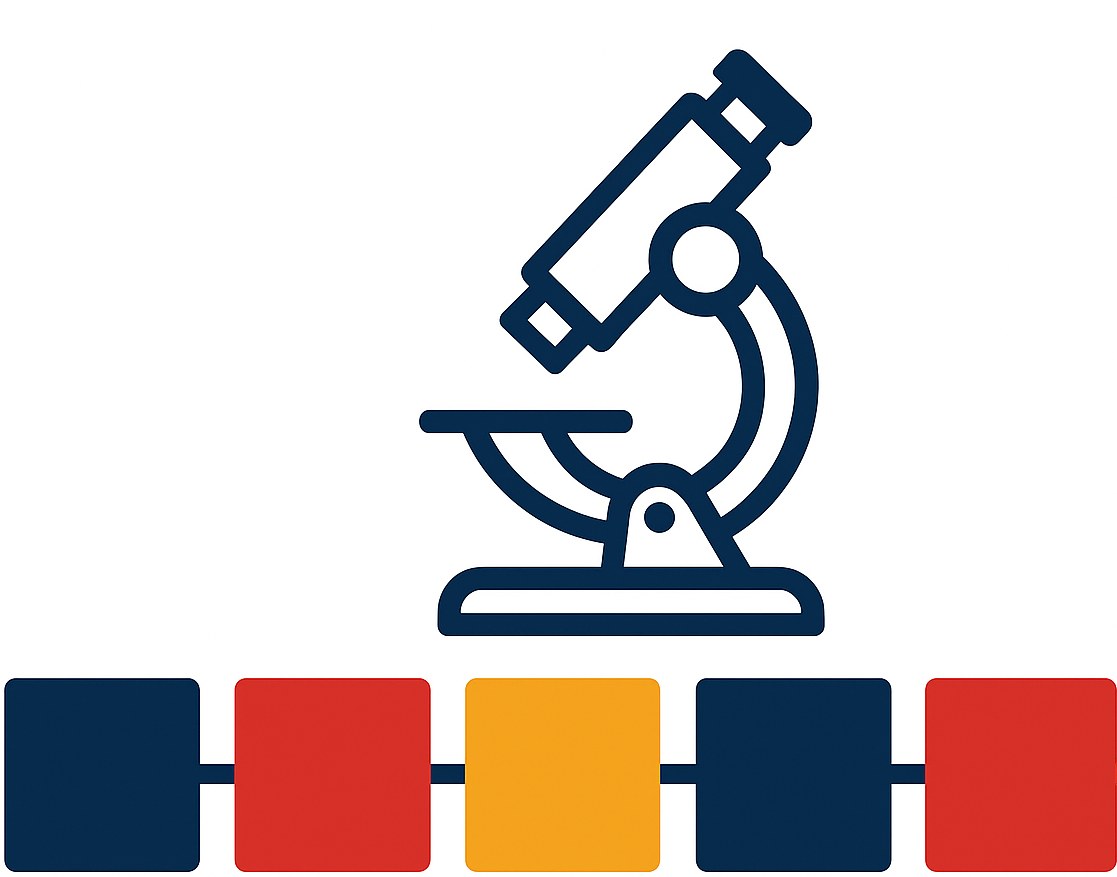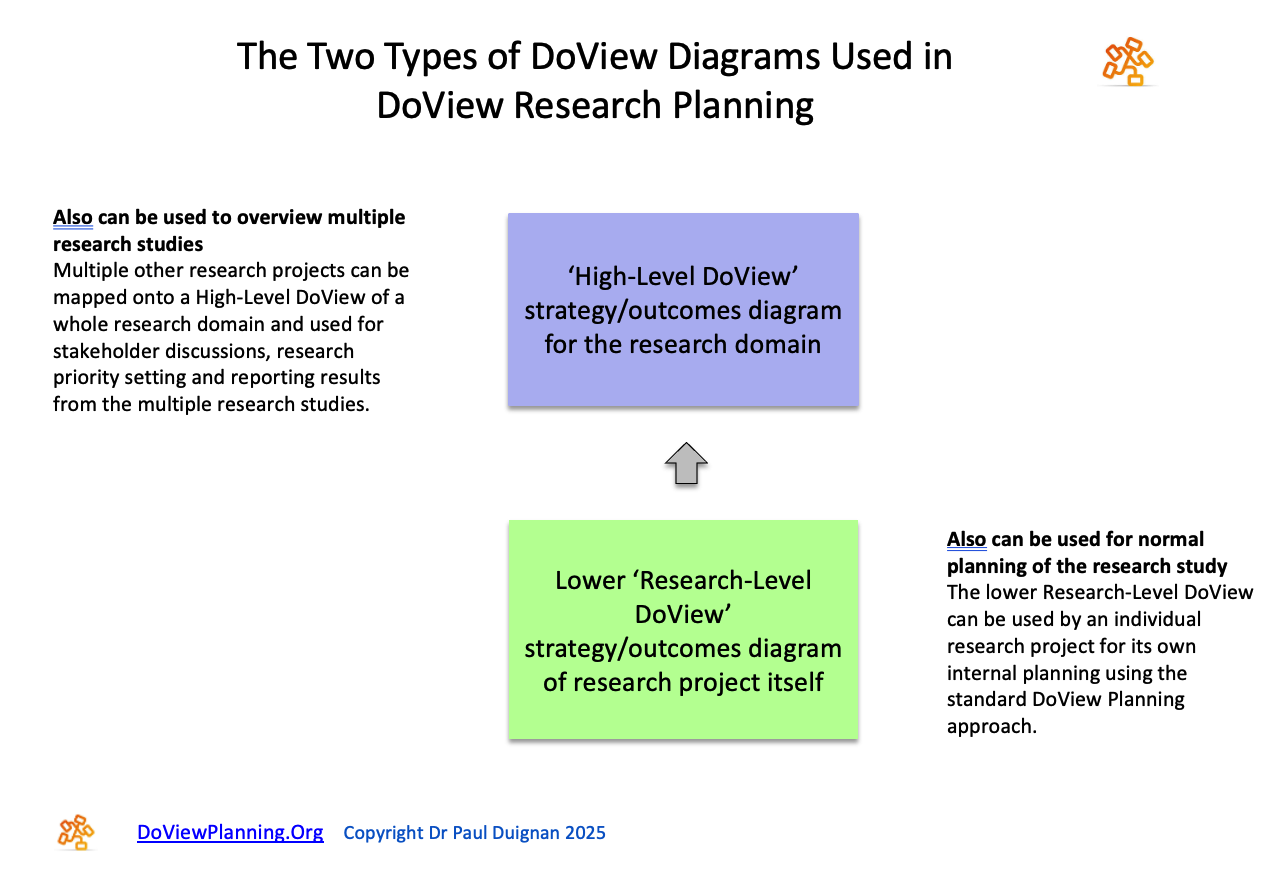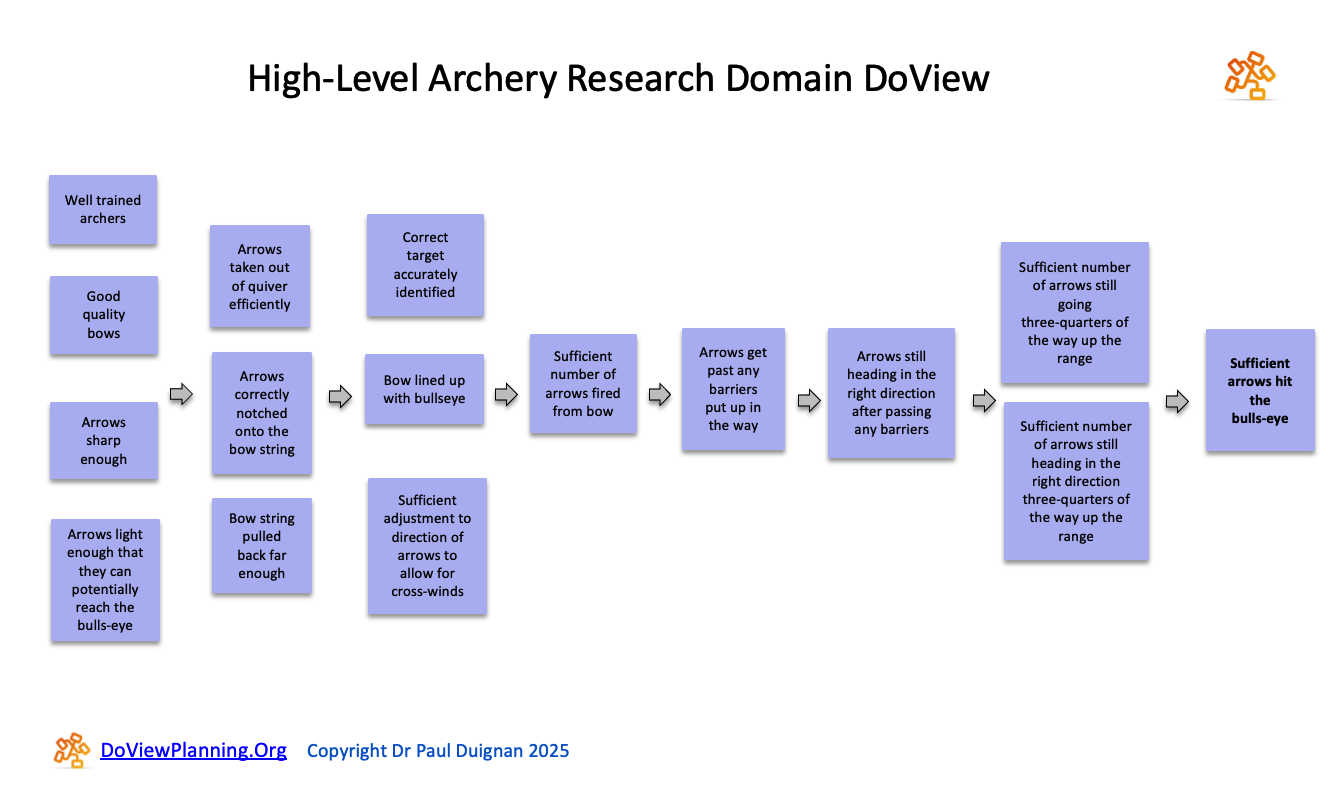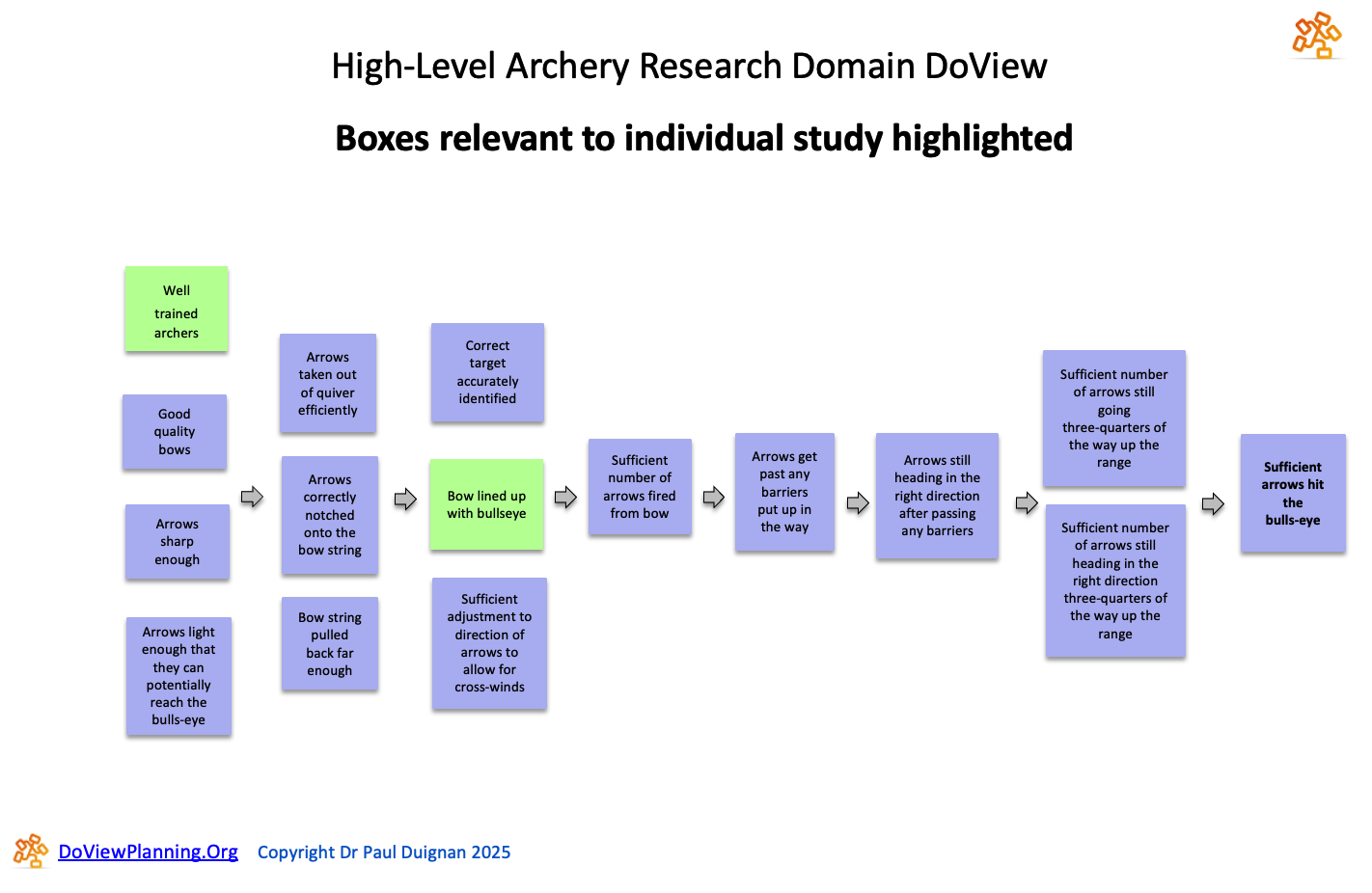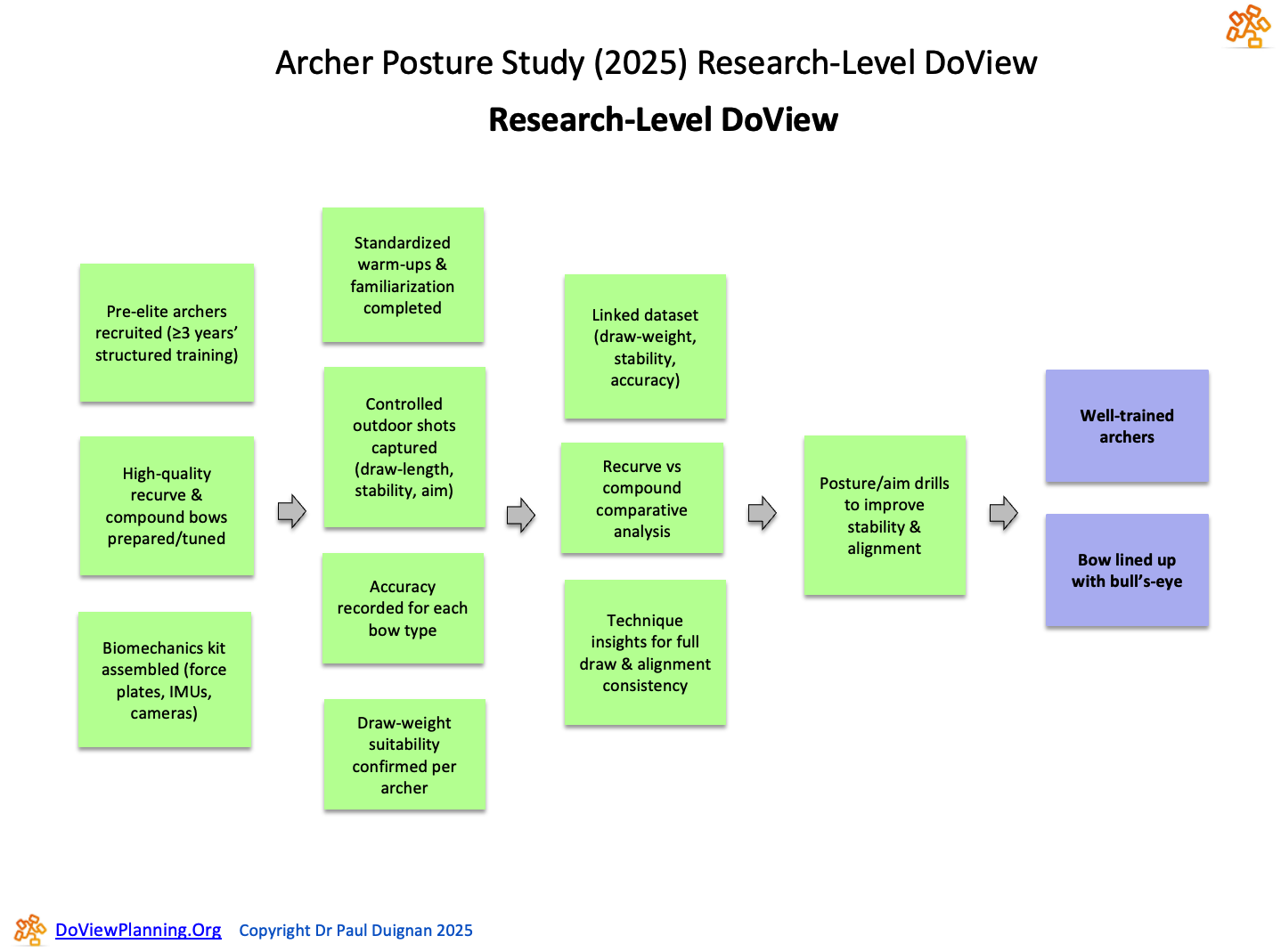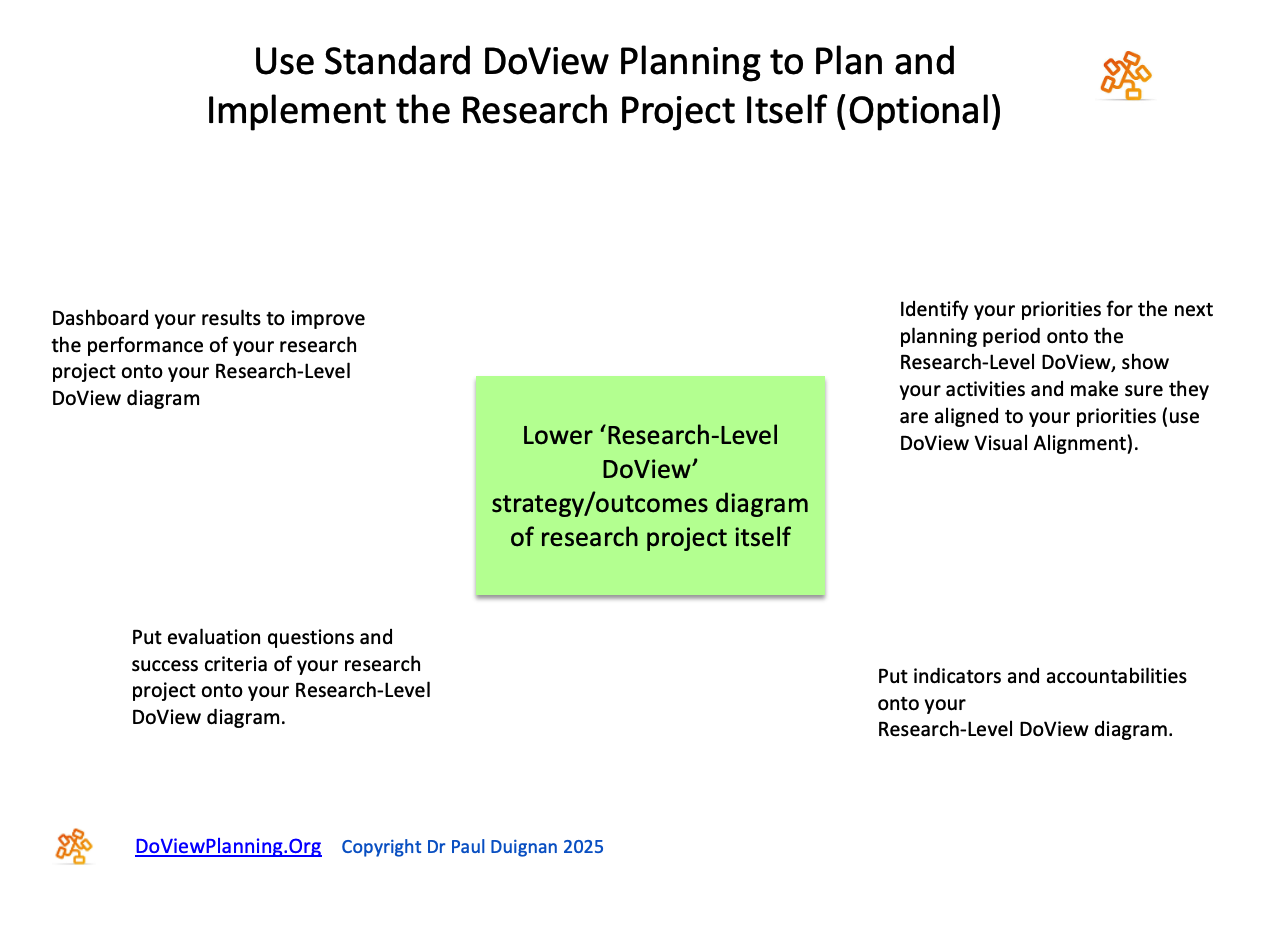DoView Research Planning
Planning research and communicating research outcomes to funders and stakeholders
The New Visual Planning for Everyone
Quick overview
How researchers can use DoView Research Planning to clearly communicate their research outcomes to stakeholders and decision-makers; better plan their research by identifying the steps involved in it; show which of their activities focus on specific research steps; and specify the measures they will use and the research questions they are answering.
A real-world example of research is used to show how DoView Research Planning can be applied to research planning.
The claim here is that DoView Research Planning is a better way to plan research, communicate its methodology and outcomes to other researchers, stakeholders and decision-makers and improve understanding of where a specific piece of research fits within the wider research domain.
Anyone can use DoView Research Planning freely, in profit or nonprofit settings (with acknowledgment) and do it in PowerPoint, Google Slides, or the DoView legacy app. If you want help applying it in your situation, get in touch.
DoView Research Planning is divided into six steps as outlined below.
The research project used to illustrate using DoView Research Planning (Fan et al 2025).
There is a research paper–Archer Posture Study (2025)- which is an actual published research study that happens to be relevant to the mocked-up illustrative Archery Initiative DoView that is used throughout this website to illustrate DoView Planning. It is shown below.
A. Identify high-level outcomes and steps in a ‘High-Level DoView’ strategy/outcomes diagram for the research domain
The first step in using DoView Research Planning is to describe the overall research domain’s outcomes and the steps believed will lead to achieving them. This is done by drawing a high-level DoView strategy/outcomes diagram for the whole research domain. In the case of the Archery Posture Study (2025) example being used here, the standard Archery Initiative DoView diagram, used throughout this website, can be seen as the high-level research domain DoView diagram for this research project. Researchers often will need to build one of these for their particular research project.
Consensus Research Domain DoViews
Consensus high-level DoViews can be developed for any research domain, and if researchers were made aware of them, they could then map their particular research projects onto them. Drafts of these could be built using the AI DoView Drawing Prompt. Then, ideally, these could be amended and validated by a group of researchers, stakeholders and decision-makers to make sure that they represent the outcomes being sought in the particular research domain. Where such high-level research domain DoViews are developed, they can be used for the following:
Mapping multiple research projects being undertaken in the domain onto a common set of outcomes represented within the high-level research domain DoView diagram.
Mapping research results so that researchers, stakeholders and decision-makers can clearly see them in the context of the outcomes being sought in the domain.
Identifying possible priority research questions that should be researched.
Registering research projects to show which areas are currently being actively researched.
Forming the basis for evidence-based DoViews, which can then be used in the field to encourage evidence-based practice being undertaken by those implementing initiatives in the relevant area.
Such high-level research domain DoViews can also be used by a sector or individual organizations or initiatives for the other aspects of DoView Planning, such as determining priorities, identifying indicators and accountabilities and proving impact.
Two types of DoView strategy/outcomes diagrams are therefore used in DoView Research Planning. The relationship between them and ways they can be used are shown below.
As with any other DoView strategy/outcomes diagram, a research domain’s High-Level DoView diagram is created according to the set of DoView Drawing Rules. Many different types of visual outcomes models can be developed, however using the DoView rules ensures that your diagram will be suitable for all stages of DoView Research Planning. To demonstrate how to carry out DoView Research Planning, an illustrative DoView diagram made in PowerPoint is used as the High-Level DoView for the example on this page. It is a DoView of a fictitious ‘Archery Initiative’ that is used as an example throughout this website. The Archery Initiative DoView outlines all of the steps needed to achieve the high-level outcomes of the ‘Archery Initiative’. You can create a High-Level DoView yourself for any research domain by following the DoView Drawing Rules, or use the free ChatGPT AI DoView Drawing Prompt to generate an initial draft in PowerPoint. The specific fictitious Archery Initiative DoView diagram being used here is a single-page one, but as discussed on the Method page, real-world High-Level DoViews typically consist of multiple drill-down subpages. Look at some examples of real-world DoViews.
B. Show the specific boxes in the High-Level DoView diagram that the research project is focused on
In traditional approaches to communicating a research project’s high-level outcomes, a narrative description is provided that describes the outcomes the specific research is ultimately focused on improving. Alternatively, visualising research outcomes within the relevant High-Level DoView offers a faster way for other researchers, stakeholders, and decision-makers to understand what a research project is aiming to achieve. This is particularly true if the particular High-Level DoView has been developed not only by researchers, but also in conjunction with stakeholders and decision-makers. It is even more useful if stakeholders and decision-makers are already using the same DoView themselves to help them think about outcomes in the domain and the steps needed to achieve these. For instance, research funders could be using the High-Level DoView as part of ongoing research priority setting, and stakeholders could be using it as part of planning when implementing interventions on the ground to improve outcomes in the domain, not just using it for research.
In addition, when multiple research projects are being undertaken within a domain, having a High-Level DoView available for researchers to map their project onto offers a standardised set of descriptors for steps and outcomes for the set of research projects. Otherwise, different research projects may describe the domain-level outcomes they aim for in different ways. Just doing it the traditional way rather than using DoView Planning leads to a higher cognitive load and a lack of clarity for those who want to quickly understand the research activity being conducted in the domain, as well as to identify gaps and overlaps.
DoView Research Planning High-Level Research Strategy Workshops
There is every reason to develop High-Level DoViews for any domain. These could be created by running DoView Research Planning Research Strategy Workshops. Such workshops would involve researchers, stakeholders, funders and decision-makers. An initial draft of the High-Level DoView could be produced for the domain using the ChatGPT AI DoView Drawing Prompt, which workshop participants would discuss and refine. It would then be made available for everyone in the sector to map their activities onto and used for various purposes by researchers, stakeholders, decision-makers, and initiatives working within the sector. It could then be updated regularly in follow-up workshops.
Below is a marked-up version of the High-Level Archery Initiative DoView strategy/outcomes diagram. Highlighted in green are the specific boxes that the example research project, the Archers’ Posture Study (2025), is focused on.
C. Draw a ‘Research-Level DoView’ Diagram
In this step, you can draw a Research-Level DoView strategy/outcomes diagram yourself using the DoView Drawing Rules. Or you can use the ChatGPT AI DoView Drawing Prompt to develop a draft DoView in PowerPoint, which you can then amend to accurately represent the steps and outcomes you aim to achieve through your research project. A Research-Level DoView strategy/outcomes diagram for the Archer’s Posture Study (2025) is shown below, setting out the lower-level practical steps and outcomes the research involves. This can be used in conjunction with the High-Level DoView research domain diagram, shown directly above, which shows the boxes that the research project is focused on in the context of the whole research domain. In the Research-Level DoView shown below you can see that the two boxes at the end of the diagram (the blue ones) are both from the High-Level Research Domain DoView above.
D. Use standard DoView Planning to plan and implement the research project itself (optional)
DoView Research Planning can provide significant value just by using Steps A and B in the process, as discussed above. These are developing, or using an existing High-Level DoView, of the research domain and mapping the specific outcomes of your research project onto that High-Level DoView. In Step C, you can use your Research Level DoView to explain to other researchers, funders, stakeholders and decision-makers exactly what you are planning to do in your research project and how they will lead to the outcomes from the High-Level DoView of the research domain that your piece of research is focusing on.
Given that you have developed your Research-Level DoView in Step C above, you have the option of then using that Research-Level DoView for implementing your actual research project. To do this, you just use the normal DoView Planning approach that can be used to plan and implement any initiative as is set out on our Method page.
E. Put measures and research questions onto the Research-Level DoView diagram
Regardless of how much you use standard DoView Planning with your research project, it is always helpful to map your research project’s measures and specific research questions onto your research project’s Research-Level DoView to be able to quickly describe your research project to others. This provides a quick way for anyone to understand what you are measuring in your research and which specific research questions you are trying to answer. It would be very useful if a Research-Level DoView, marked up with measures and research questions, was always published together with any published research report. If this was done, any reader could quickly look at the DoView and immediately see what the research project is attempting to do. Below shows the Research-Level DoView for the Archer’s Posture Study (2025) with measures and research questions mapped directly onto the DoView.
Lower Cognitive Load
The purpose of using DoView Research Planning is to reduce the cognitive load associated with understanding a research project. Traditionally, as a person reads a research report, the idea is that they will pick up on what is being measured and what research questions are being asked. The implicit belief is that they can immediately locate the research project’s measures and research questions on their mental model of what the research is attempting to achieve. This relies on the size of the reader’s working memory, how tired they are and how good they are at constructing mental models of what a research project is trying to achieve. In contrast, using a DoView diagram with measures and research questions mapped onto it is far more efficient and has a lower cognitive load for the reader.
Shared Thinking Tool
In addition, the DoView approach has the advantage that the DoView diagram can be used as a ‘shared thinking tool’ because it has been externally visualized outside of individual peoples’ minds. People discussing the research project against such a shared externalized model means that they can confirm that they all have a similar view of what it is that the particular research project is trying to achieve. Without this external visual shared thinking tool as an aid, one ends up having to rely on extended verbal or written discussions. This is as they try to communicate and assess the commonalities between their potentially somewhat differing mental models of what a particular research project is trying to achieve.
F. Report Your Results Onto the DoView(s)
The results of the research project can be reported back onto the Research-Level DoView to quickly allow a reader to work out what has been found in the research project. In some cases, it can add value to also map summaries of your research findings back onto the High-Level Research Domain DoView. In addition, there is no reason why research findings from multiple research projects can not be mapped back onto the High-Level DoView. Obviously, if such mapping was done for a research domain, the mapped DoViews would prove invaluable for other researchers wanting to work out what is known so far in the domain and future research directions. In addition, research funders, stakeholders, decision-makers and those running initiatives in the domain could use such a High-Level DoView to help think about, plan and implement their work.
Below shows the Research-Level DoView for the Archer’s Posture Study (2025) with results reported onto the DoView.

